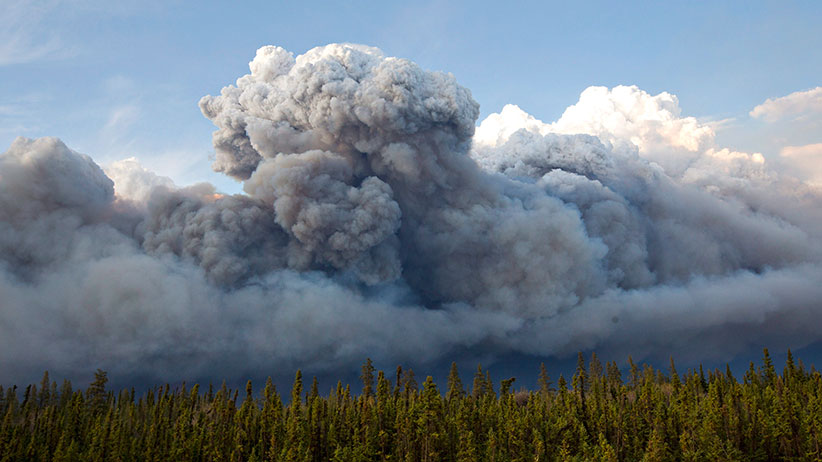What needs to happen to the weather to help Fort McMurray?
A Q&A with a scientist who specializes in forest fires, on what needs to happen for the Fort McMurray fires to go out
Smoke rises above trees as a wildfire burns in Fort McMurray, Alta., on Wednesday May 4, 2016. The wildfire has already torched 1,600 structures in the evacuated oil hub of Fort McMurray and is poised to renew its attack in another day of scorching heat and strong winds. (Jason Franson/CP)
Share

As hundreds of firefighters battle in and around Fort McMurray, everyone is carefully monitoring the weather in the hopes that Mother Nature will come to the rescue. Right now, there’s no way for firefighters to put out the fire unless the weather shifts. Dr. Kerry Anderson, a research scientist with the Canadian Forest Service in Edmonton, specializes in research on forest fires. He explains how the weather could help, or hurt, fire fighting efforts.
Q: What needs to change in the weather for the fire to go out?
A: We need the temperatures to fall, we need the humidity to go up and we need the winds to calm down.
Q: How much does the temperature need to drop? How cold does it need to get?
A: Generally speaking extreme fire behaviour happens when the temperature in Celsius exceeds the percentage of relative humidity. [The temperature in Fort McMurray is currently at 17 degrees celsius, and the humidity is at 22 per cent; on Wednesday, when the fire grew substantially, the temperature hit 31.7 degrees and the humidity reached a low of 13 per cent.] That’s usually a red flag for extreme fire behaviour. So if humidity increases and the temperature is cool—like in the 20s, while the humidity is in the 40s—that will probably settle things down. Also if clouds come overhead, that tends to settle down fire behaviour as well.
Q: If there’s rain, or just the clouds by themselves?
A: I have not talked about rain. Obviously rain is an important factor here. If it rains that would have a great impact on the potential fire behaviour, but it takes a lot more than just a little sprinkling to put these fires out. A fire such as this Fort MacMurray fire is going to need 50 mm or 100 mm of rain to put it out, so that’s really not in the forecast, not for the next few weeks.
Q: Is there a temperature drop forecasted?
A: With this cold front that came through last night the temperatures in Alberta have dropped quite dramatically, we’re perhaps five or more degrees cooler than we were yesterday and along with this cooler temperature the humidity went up so we are getting a bit of a break in terms of the potential fire behaviour. But the indication is that’s going to be short-lived and things are probably going to ramp up again early next week.
Q: Is there any way to induce that? Is there any way for humans to encourage those things to take place? For instance, cloud seeding?
A: No, there has been weather modification done in the past but a lot of that stuff is on shaky ground. That was work that was done in the ’70s and ’80s. [Cloud seeding] is not a science that’s really being pursued aggressively these days.
